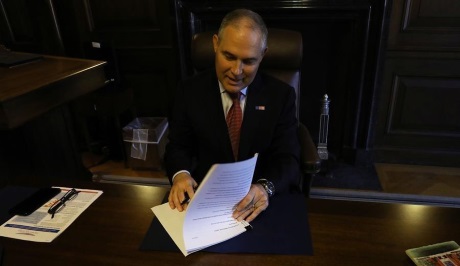EPA takes steps to repeal US Clean Power Plan
11 October 2017
The US Environmental Protection Agency (EPA) yesterday issued a notice of a proposed rule that would repeal the 2015 Clean Power Plan (CPP). The EPA asserts that the regulation, which would set emissions standards for US power plants, exceeds the agency's statutory authority.
 |
| Scott Pruitt signs the Notice of Proposed Rulemaking (Image: EPA) |
The Notice of Proposed Rulemaking was submitted yesterday by Administrator Scott Pruitt, who was nominated by President Trump to head the EPA earlier this year. It follows the EPA's completion of a review of the rule, which was introduced by the previous US administration under former president Barack Obama.
"After reviewing the CPP, EPA has proposed to determine that the Obama-era regulation exceeds the Agency's statutory authority. Repealing the CPP will also facilitate the development of US energy resources and reduce unnecessary regulatory burdens associated with the development of those resources, in keeping with the principles established in President Trump's Executive Order on Energy Independence," the EPA said yesterday.
The presidential order, signed on 28 March, gave US executive departments and agencies 180 days to conduct a review of existing actions described as harmful to US energy production. It called for an immediate re-evaluation of the CPP, regulation which Trump said at the time threatened US miners, energy workers and companies.
The EPA introduced the CPP in August 2015 in an effort to cut US CO2 emissions by 32% from 2005 levels by 2030. It sets emissions standards for power plants and customised goals for states to cut carbon pollution. The plan was to have been implemented by the end of 2015, but in February 2016 the US Supreme Court stayed its implementation pending judicial review.
"The Obama administration pushed the bounds of their authority so far with the CPP that the Supreme Court issued a historic stay of the rule, preventing its devastating effects to be imposed on the American people while the rule is being challenged in court," Pruitt said yesterday. "Any replacement rule will be done carefully, properly, and with humility, by listening to all those affected by the rule," he said.
According to the EPA, the CPP was premised on a "novel and expansive view of Agency authority". The Trump administration now proposes to determine that the CPP is inconsistent with the Clean Air Act. Repeal of the CPP could save up to $33 billion in avoided compliance costs in 2030, the EPA said.
The notice has now been sent to the US Federal Register for publication, after which the public will have 60 days to submit comments.
Reasonable regulation
Scenarios released by the EPA in 2015 suggested that the pattern of future carbon dioxide emissions from the USA's power sector would depend significantly on whether or not the CPP was implemented. However, President Trump in June announced his intention to withdraw the USA from the Paris Agreement on climate change, with the aim of renegotiating its contribution.
Senator John Barrasso, Republican chairman of the Senate Committee on Environment and Public Works, attended Pruitt's signing of the proposed rule. Barrasso said he was glad to see the EPA take formal steps to repeal the CPP. "The EPA is supposed to issue reasonable regulations to protect America's air. The Clean Power Plan was unreasonable and unlawful," he said.
However, the top Democrat on the committee, Senator Tom Carper, said repealing the CPP would have "serious consequences" for public health and for the planet. "Today, President Trump and Mr Pruitt are on the wrong side of history," he said. "They are not just ignoring clear facts. They are creating their own reality, complete with rigged science and math, to justify doing nothing in the face of the greatest environmental challenge of our lifetime."
Although it allows credit for new nuclear power plants and uprates to existing units, the CPP does not recognise the role of existing nuclear capacity and does not credit nuclear licence extensions on the same basis as new capacity. A rule proposed by US Energy Secretary Rick Perry on 28 September would recognise the attributes of baseload generating sources including nuclear for their contribution to grid stability.
One state that has already enacted legislation to enforce the development of renewable energy and to cut carbon emissions is New York. The state's Clean Energy Standard, approved by the New York Public Service Commission in August 2016, also explicitly recognises the zero-carbon contribution of nuclear power plants, helping ensure their continued operation.
New York State Governor Andrew Cuomo said yesterday the administration's move to dismantle the Clean Power Plan was a "reckless decision" putting industry interests ahead of the ability to reduce damaging emissions. "Climate change is a profound threat to our planet, and it cannot be wished away by denial," he said.
"There is no denial here in New York," Cuomo said. "New York is on track to meet our ambitious target of achieving 50% of electricity from renewables by 2030, and we will continue to lead the fight to meet the standards set forth in both the Paris Accord and the Clean Power Plan."
Researched and written
by World Nuclear News